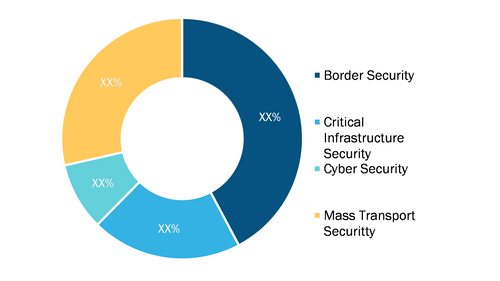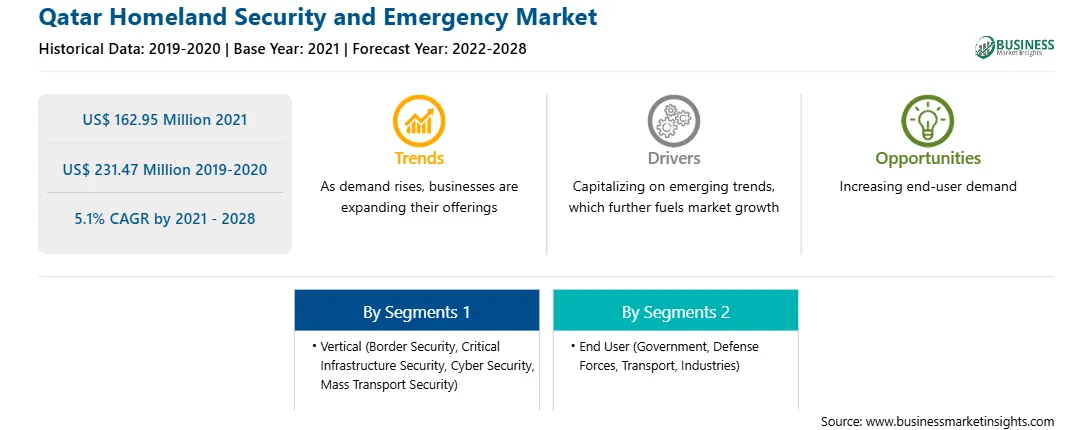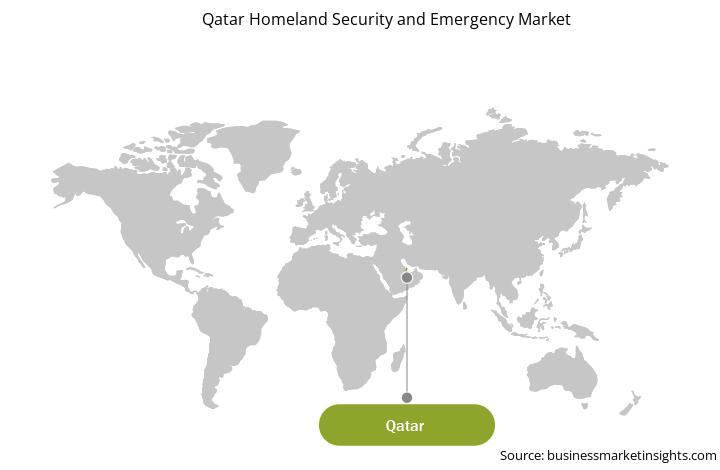Market Introduction
With rising concerns about security in government organizations, industries, and enterprises in Qatar, technology experts are focusing on offering solutions based on improved security protocols to combat cyber threats. They are capitalizing on multilayered approach to safeguard and prevent users from accessing malicious fields, which might be the sources of malware. Factors contributing to the homeland security and emergency market growth in Qatar include the deployment of automation and security technologies in airports, railways, and bus transport infrastructure, among others; the integration of advanced technologies such as facial recognition and biometrics in financial institutions; and rising inclination toward enhancing cybersecurity as a result of the mounting number of cyberattacks in banks and industries. These factors are collectively boosting the deployment of advanced and sophisticated technologies in banks; oil & gas, energy & power, telecommunications, military & defense, and government sectors; and airports, railways, roadways, and seaports. In Q1 2020, Qatar recorded 2,033 e-mail, URL, and file threats associated with COVID-19, registering the second-highest number of threats in the Gulf Cooperation Council (GCC). As a result, the country government is compelling experts and officials to investigate and deploy better security systems for protecting nation’s businesses, which is projected to boost the adoption of advanced security systems across Qatar in the coming years.
The transportation industry in Qatar is adopting advanced technologies and intelligent systems to ensure seamless activities. Sophisticated technologies are being deployed at airports, railways, roadways, and seaports. With an escalating demand for AI solutions from customers in Qatar, the implementation of AI trials is also growing. For instance, the Integrated Automated Fare Collection and Ticketing System is a new system developed for public transportation in Qatar. The Ministry of Transport and Communications (MoTC) signed a partnership with MSI Global (Taiwan) and GBM Qatar for the development of new systems to unify ticketing mechanism for public transport in Qatar’s internal transportation network. The latest credit card payment technologies, and payment through smartphones and smartwatches are supporting the evolution of the transportation industry in the country. Similarly, Ashghal—a Public Works Authority of Qatar—is in the last stage of preparing an Intelligent Transport System (ITS) master plan, whereas smart transport solutions have already been integrated in traffic system of the country. The authority is planning to execute fully integrated ITS before FIFA World Cup 2022. Moreover, in May 2019, the country revealed the second phase of its “Smart Airport program,” with a plan to introduce biometric systems throughout the journey of passengers. This facial recognition technology is already in use at Hamad International Airport at boarding and bag-drop counters. Moreover, Thales Group is providing advanced communications-based train control (CBTC) signaling; passenger services; communications and security; fully integrated operational control center; and automatic fare collection systems such as access gates, ticket vending machines, and transaction management systems for Doha Metro. Moreover, the company is also offering a fully integrated solution for supervision, security, telecommunication, and fare collection systems for new Lusail Tram Project in Qatar. The adoption of automation and security technologies, such as biometrics, in the transportation industry, thus driving the homeland security and emergency market growth in Qatar.
Market Overview and Dynamics
The Qatar’s banking sector is evolving heavily. It has been noticed that Qatari financial institutions are signing collaborations with the Fintech companies and targeting young digital-savvy end users in Qatar and overseas. The banking industry in Qatar is looking forward for implementing advanced technologies such as AI, machine learning, robotics, and Blockchain. Owing to the fact that the banking sector in the country has been a target for cyberattacks, the sector is procuring new technologies into their systems to ensure the protection of valuable business assets. In 2019, the phishing attempts and user-targeted social engineering attacks depicted over half of the total attacks, while rest of attacks were aimed at the systems and network infrastructure. Therefore, the banking sector in Qatar is taking steps to secure its operations and client data.
Improving customer experience (CX), online banking communication, open banking application programming interfaces (APIs), and biometric access are among the solutions transforming the banking sector operations in Qatar, further assisting in mitigating cyber-attacks in the country.
Key Market Segments
The homeland security and emergency market in Qatar is segmented on the basis of vertical and end user. Based on vertical, the market is further segmented into border security, critical infrastructure security, cyber security, and mass transport security. The border security segment held the largest share of the homeland security and emergency market in Qatar in 2020. On the basis of end user, the market is segmented into government, defense forces, transport, and industries. In 2020, the defense forces segment dominated the homeland security and emergency market.
Major Sources and Companies Listed
A few major primary and secondary sources referred to for preparing this report on the Qatar homeland security and emergency market are company websites, annual reports, financial reports, national government documents, and statistical databases. Major companies listed in the report are Advanced Information and Security Solutions, ATOS SE, BAE Systems, Bayanat Engineering Qatar, Globesoft Qatar, HIT Security, Nobel Security Solution Qatar, Protiviti, Seniors IT, and Thales Group.
Reasons to Buy This Report
Qatar Homeland Security and Emergency Market Segmentation
Qatar Homeland Security and Emergency Market –
By Vertical
Qatar Homeland Security and Emergency Market –
By
End-User
Qatar Homeland Security and Emergency Market - Company Profiles
Strategic insights for the Qatar Homeland Security and Emergency provides data-driven analysis of the industry landscape, including current trends, key players, and regional nuances. These insights offer actionable recommendations, enabling readers to differentiate themselves from competitors by identifying untapped segments or developing unique value propositions. Leveraging data analytics, these insights help industry players anticipate the market shifts, whether investors, manufacturers, or other stakeholders. A future-oriented perspective is essential, helping stakeholders anticipate market shifts and position themselves for long-term success in this dynamic region. Ultimately, effective strategic insights empower readers to make informed decisions that drive profitability and achieve their business objectives within the market.

| Report Attribute | Details |
|---|---|
| Market size in 2021 | US$ 162.95 Million |
| Market Size by 2028 | US$ 231.47 Million |
| CAGR (2021 - 2028) | 5.1% |
| Historical Data | 2019-2020 |
| Forecast period | 2022-2028 |
| Segments Covered |
By Vertical
|
| Regions and Countries Covered | Qatar
|
| Market leaders and key company profiles |
|
The geographic scope of the Qatar Homeland Security and Emergency refers to the specific areas in which a business operates and competes. Understanding local distinctions, such as diverse consumer preferences (e.g., demand for specific plug types or battery backup durations), varying economic conditions, and regulatory environments, is crucial for tailoring strategies to specific markets. Businesses can expand their reach by identifying underserved areas or adapting their offerings to meet local demands. A clear market focus allows for more effective resource allocation, targeted marketing campaigns, and better positioning against local competitors, ultimately driving growth in those targeted areas.

The Qatar Homeland Security and Emergency Market is valued at US$ 162.95 Million in 2021, it is projected to reach US$ 231.47 Million by 2028.
As per our report Qatar Homeland Security and Emergency Market, the market size is valued at US$ 162.95 Million in 2021, projecting it to reach US$ 231.47 Million by 2028. This translates to a CAGR of approximately 5.1% during the forecast period.
The Qatar Homeland Security and Emergency Market report typically cover these key segments-
The historic period, base year, and forecast period can vary slightly depending on the specific market research report. However, for the Qatar Homeland Security and Emergency Market report:
The Qatar Homeland Security and Emergency Market is populated by several key players, each contributing to its growth and innovation. Some of the major players include:
The Qatar Homeland Security and Emergency Market report is valuable for diverse stakeholders, including:
Essentially, anyone involved in or considering involvement in the Qatar Homeland Security and Emergency Market value chain can benefit from the information contained in a comprehensive market report.